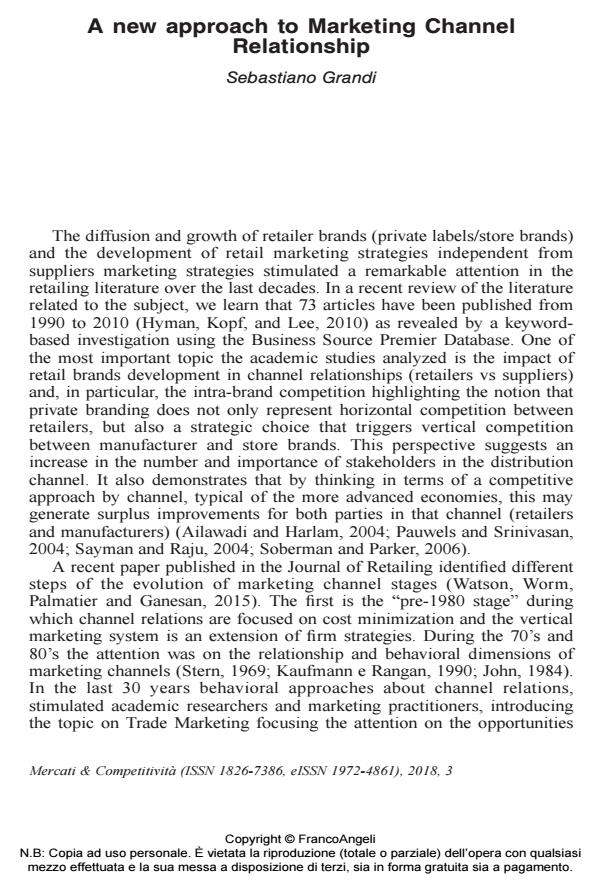A new approach to Marketing Channel Relationship
Titolo Rivista MERCATI & COMPETITIVITÀ
Autori/Curatori Sebastiano Grandi
Anno di pubblicazione 2018 Fascicolo 2018/3 Lingua Italiano
Numero pagine 4 P. 7-10 Dimensione file 54 KB
DOI 10.3280/MC2018-003001
Il DOI è il codice a barre della proprietà intellettuale: per saperne di più
clicca qui

FrancoAngeli è membro della Publishers International Linking Association, Inc (PILA)associazione indipendente e non profit per facilitare (attraverso i servizi tecnologici implementati da CrossRef.org) l’accesso degli studiosi ai contenuti digitali nelle pubblicazioni professionali e scientifiche
- Ailawadi K., Harlam B.(2004). An Empirical Analysis of the Determinants of Retail Margins: The Role of Store-Brand Share. Journal of Marketing, January, 68(1): pp. 147-165.
- Baron J.N., and Hannan M.T. (1994). The Impact of Economics on Contemporary Sociology. Journal of Economic Literature, 32(September): 1111-1146.
- Draganska M., Klapper D., Villas-Boas S.B. (2010). A Larger Slice or a Larger Pie? An Empirical Investigation of Bargaining Power in the Distribution Channel. Marketing Science, 29(January-February): 57-74.
- Frazier G.L. (1999). Organizing and Managing Channels of Distribution. Journal of the Academy of Marketing Science, 27(2).
- Geyskens I., Steenkamp J.-B.E.M., and Kumar N. (1999). A Meta-Analysis of Satisfaction in Marketing Channel Relationships. Journal of Marketing Research, 36(May): 221-238.
- Gundlach G.T., and Cadotte E.R. (1994). Exchange Interdependence and Interfirm Interaction: Research in a Simulated Channel Setting. Journal of Marketing Research, 31(November): 516-532.
- Hyman M., Kopf D., Lee D. (2010). Review of literature – Future retail suggestions: Private label brands: Benefits, success factors and future research. Journal of Brand Management, 17(5): 368-389.
- John G. (1984). An Empirical Investigation of Some Antecedents of Opportunism in a Marketing Channel. Journal of Marketing Research, 21(August): 278-289.
- Kaufmann P.J., Rangan V.K. (1990). A Model for Managing Systems Conflict During Franchise Expansion. Journal of Retailing, 66(Summer): 155-173.
- Morace F. (2015). Crescita felice. Percorsi di futuro civile. Milano: Egea.
- Palmatier R.W. (2008). Interfirm Relational Drivers of Customer Value. Journal of Marketing, 72(July): 76-89.
- Pauwels K., Srinivasan S. (2004). Who benefits from store Brand Entry?. Marketing Science, 23(3): 364-390.
- Sayman S., Raju J. (2004). How category characteristics affect the number of store brands offered by the retailer: A model and empirical analysis. Journal of Retailing, 80(4): 279-287.
- Soberman D., Parker P. (2006). The economics of quality-equivalent store brands. International Journal of Research in Marketing, 23: 125-139.
- Stern L.W. (1969). Distribution Channels: Behavioral Dimension. Boston: Houghton Mifflin.
- Varaldo R., Dalli D. (1989). Le relazioni strategiche tra industria e distribuzione. Sinergie, 19.
- Varaldo R., Fornari D. (1998). La evoluzione dei rapporti industria-distribuzione: dalla cooperazione al conflitto. Sinergie, 16(46): 21-49.
- Wang D.T., Gu F.F., and Chuoyan Dong M. (2013). Observer Effects of Punishment in a Distribution Network. Journal of Market Research, 50(October): 627-643.
- Watson G., Worm S., Palmatier R., Ganesan S. (2015). The Evolution of Marketing Channels: Trends and Research Directions. Journal of Retailing, 91(4): 546-568.
Sebastiano Grandi, A new approach to Marketing Channel Relationship in "MERCATI & COMPETITIVITÀ" 3/2018, pp 7-10, DOI: 10.3280/MC2018-003001